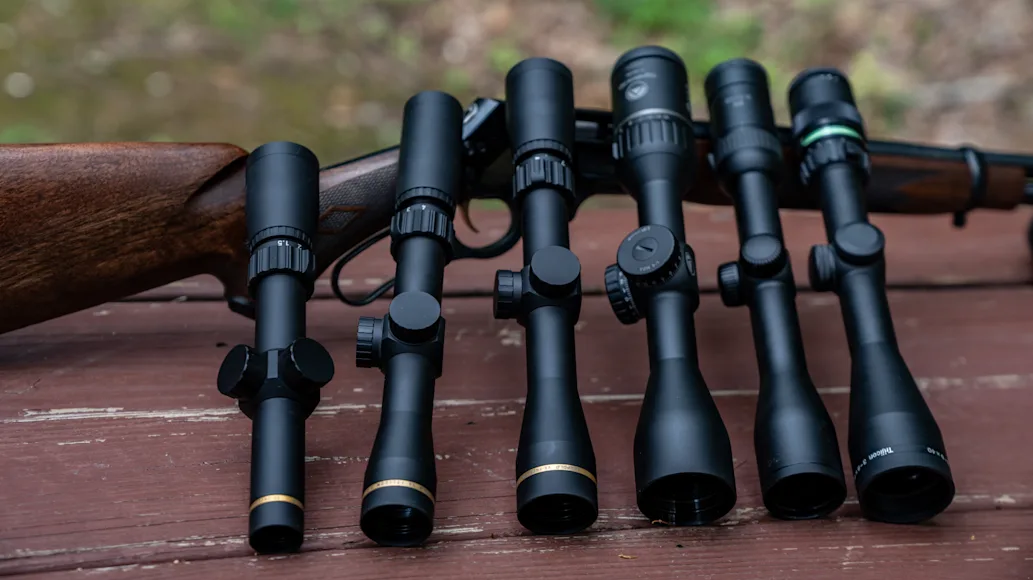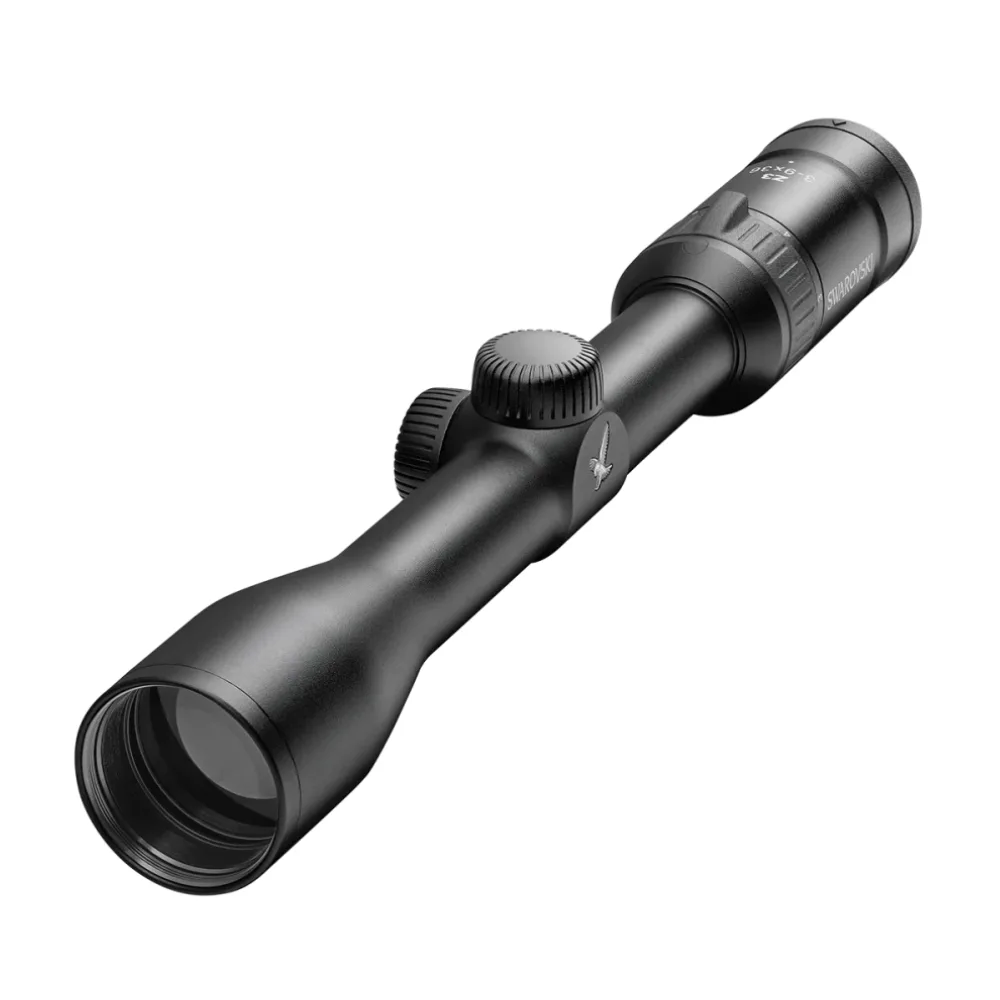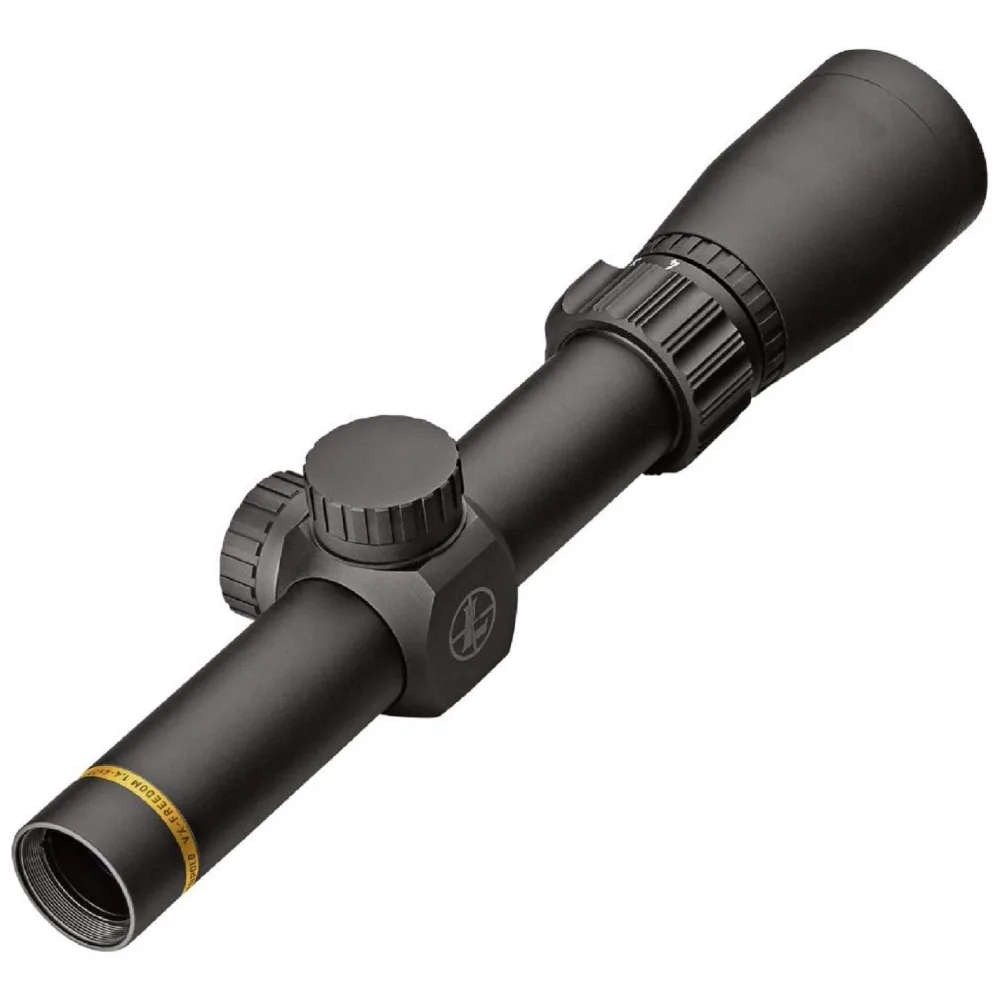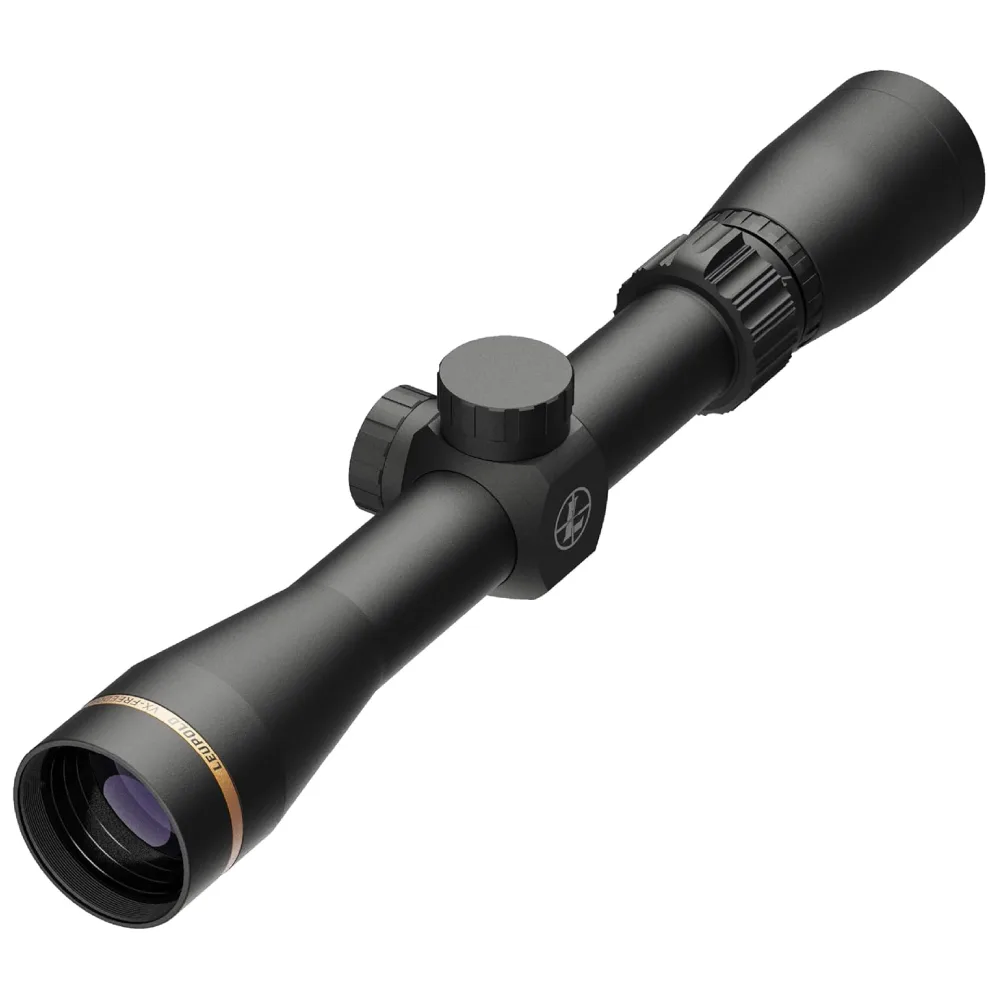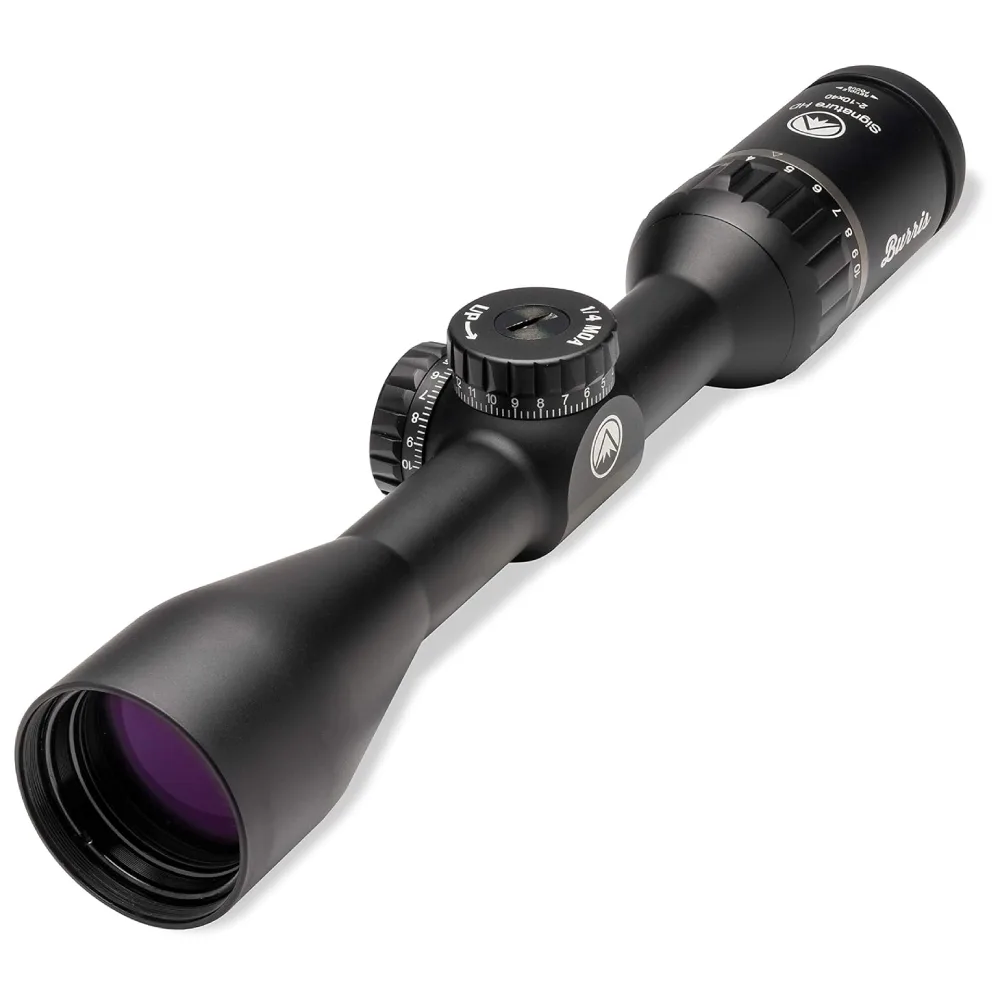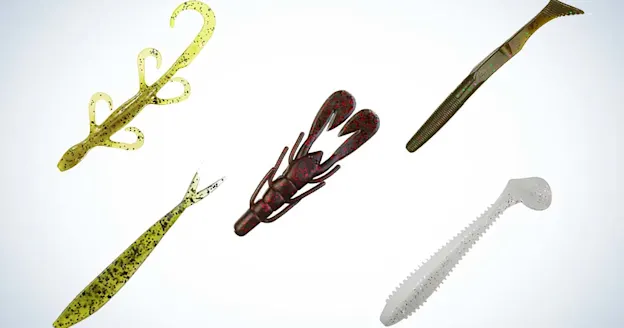We may earn revenue from the products available on this page and participate in affiliate programs. Learn more ›
We conducted a test to discover the best scope for a .30-30 rifle. This might seem odd when it seems all anyone wants to do is shoot their 6.5 Creedmoor at 1,000 yards. But the .30-30 lever-action rifle might be more popular today than ever. It is an American classic hunting rifle, and with today’s modern manufacturing methods, improved ammunition, and excellent scopes to choose from, it may be a better hunting tool now than at any other time during its existence.
We assembled what we felt were the six best rifle scopes to pair with a lever-action .30-30 rifle and put them through a series of tests to determine if they're worth the money. What amazed us most was how well all the scopes performed when examined with scrutiny and even when abused. Without question, these modern day optics are the best scopes for .30-30 rifles that hunters have ever had at their disposal.
Best Overall: Swarovski Z3 3-9X36mm
Best Budget (tie): Leupold VX Freedom 1.5-4X20mm
Best Budget (tie): Leupold VX Freedom 2-7X33mm
Best for Hunting: Trijicon 3-9X40mm AccuPoint
Rest of the Best
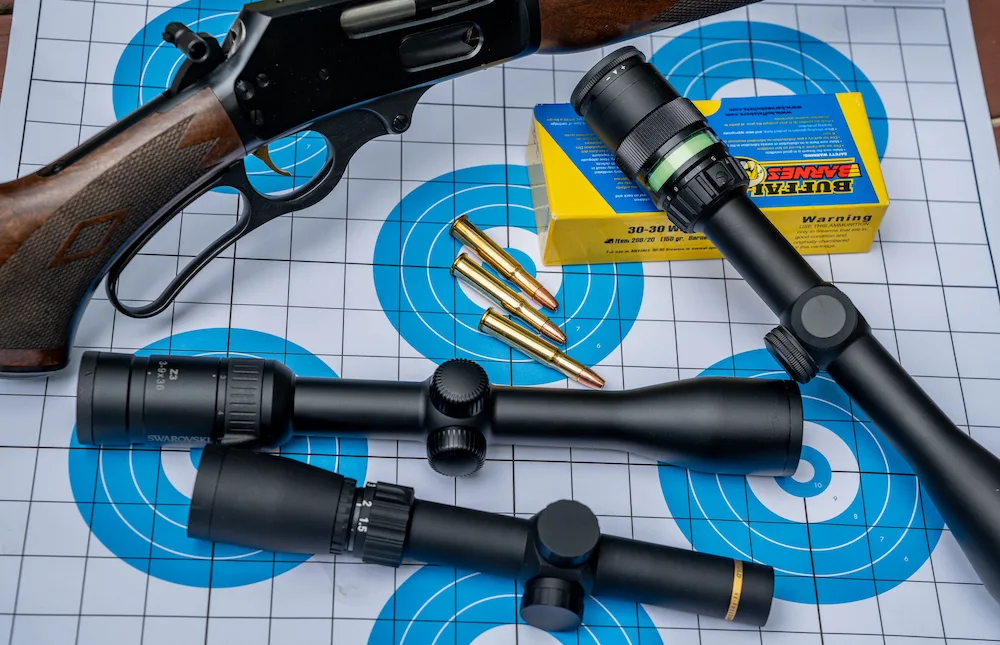
Best Overall: Swarovski Z3 3-9X36mm
Specs
Length: 12.13 inches
Weight: 12 ounces
Mounting Space: 5.45 inches
Eye Relief: 3.54 inches
Adjustment Range: 50 MOA
Parallax Setting: 109 yards
Adjustment Value: 0.25 inch
Field of View (feet @ 100 yards): 13.5 (9X) to 39.0 (3X)
Tube Diameter: 1 inch
Pros:
Fantastic resolution
Good low light performance
Not too heavy
Cons:
Pricey
A 3-9X rifle scope with a 1-inch tube has been the gold standard for hunting for decades, and the Swarovski Z3 3-9X36 is an exemplary example. The scope comes with transparent scope covers held in place with elastic straps, a microfiber lens cloth, and a comprehensive instruction manual with a link to a web-based program that details the reticle subtensions for every Swarovski reticle and riflescope. Some manufactures do a poor job of providing this information, but this website is marvelous.
The ocular and objective bells on this scope are not too large, which helps keep mounting low, and the 1-inch tube offers 5.45 inches of mounting space (the best in our test). Mounting space is important because it gives you more leeway when positioning the scope to best interface with you, the rifle, and the eye relief the scope provides. The Z3’s consistent eye relief of 3.54 inches is about average, but a tad shorter than what you’ll find with a comparable Leupold riflescope.
Like many European rifle scopes, the Z3 is metric based and the parallax is set at 100 meters or 109 yards. Similarly, the click adjustments equal 7mm per click at 100 meters or 0.25-inch at 100 yards. The adjustment dials have a zero-reset feature that gives you a reference if you want to dial in a correction or switch between loads. Swarovski offers the Z3 with two second focal plane reticles: the common duplex and the popular Euro-style 4A. Subtensions for both at any magnification setting are available online.
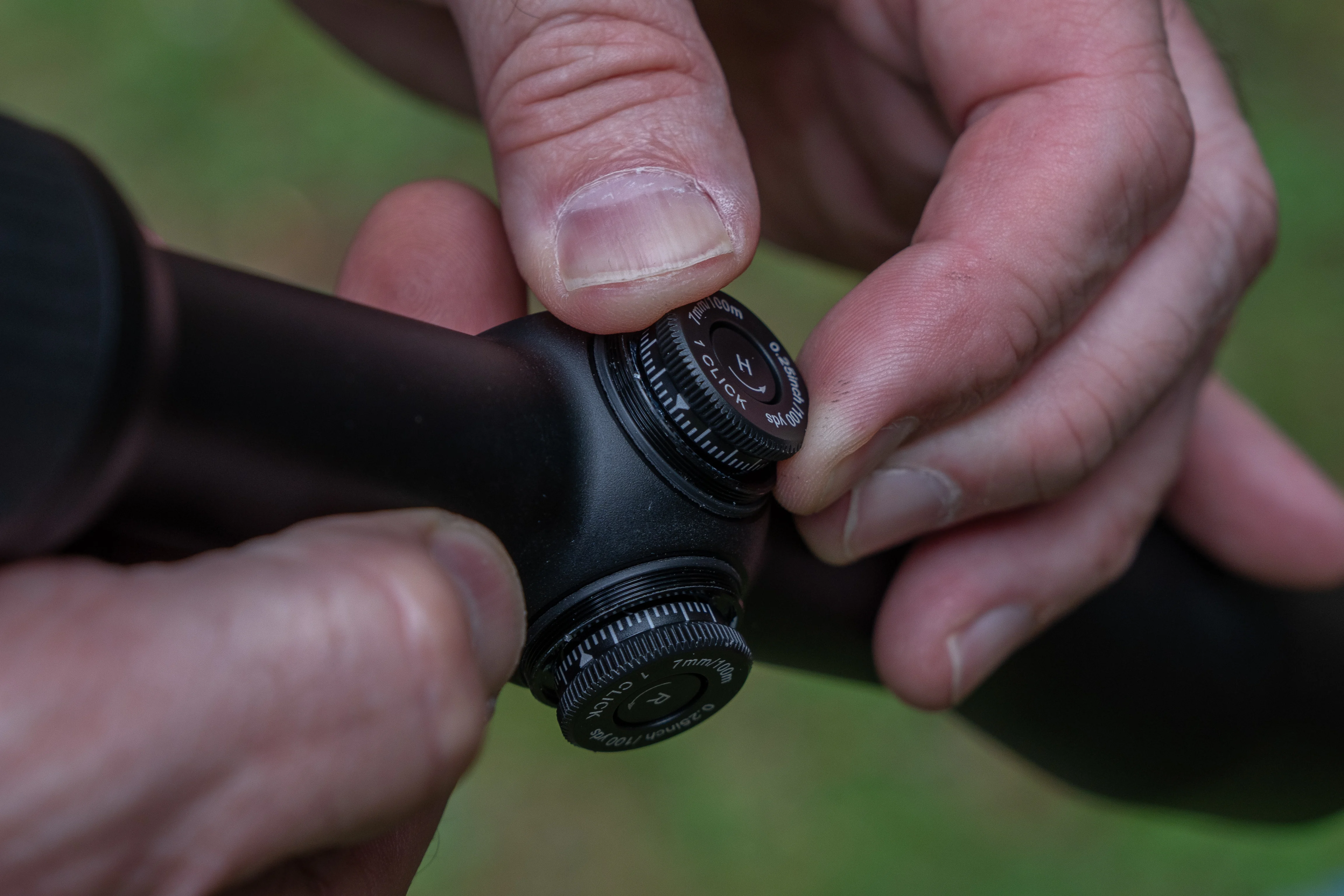
The Z3 has a functional temperature range from -4 to 131 degrees Fahrenheit and is waterproof when submerged to a depth of 13 feet. By modern standards, the Z3 is also light and compact—it weighs just 12 ounces and is only 12 inches long. Swarovski offers a 10-year warranty, and for an additional five years, they will cover the cost of parts and repairs.
During our tests, the optical clarity and low light performance of the Swarovski Z3 3-9X36mm was unmatched. Additionally, the adjustments were crisp, and the focus and resolution were prefect. The Z3 is also not overly large for a scope with a magnification range of 3-9X. Pick either reticle—both are simple and near perfect for general hunting application with a lever-action .30-30.
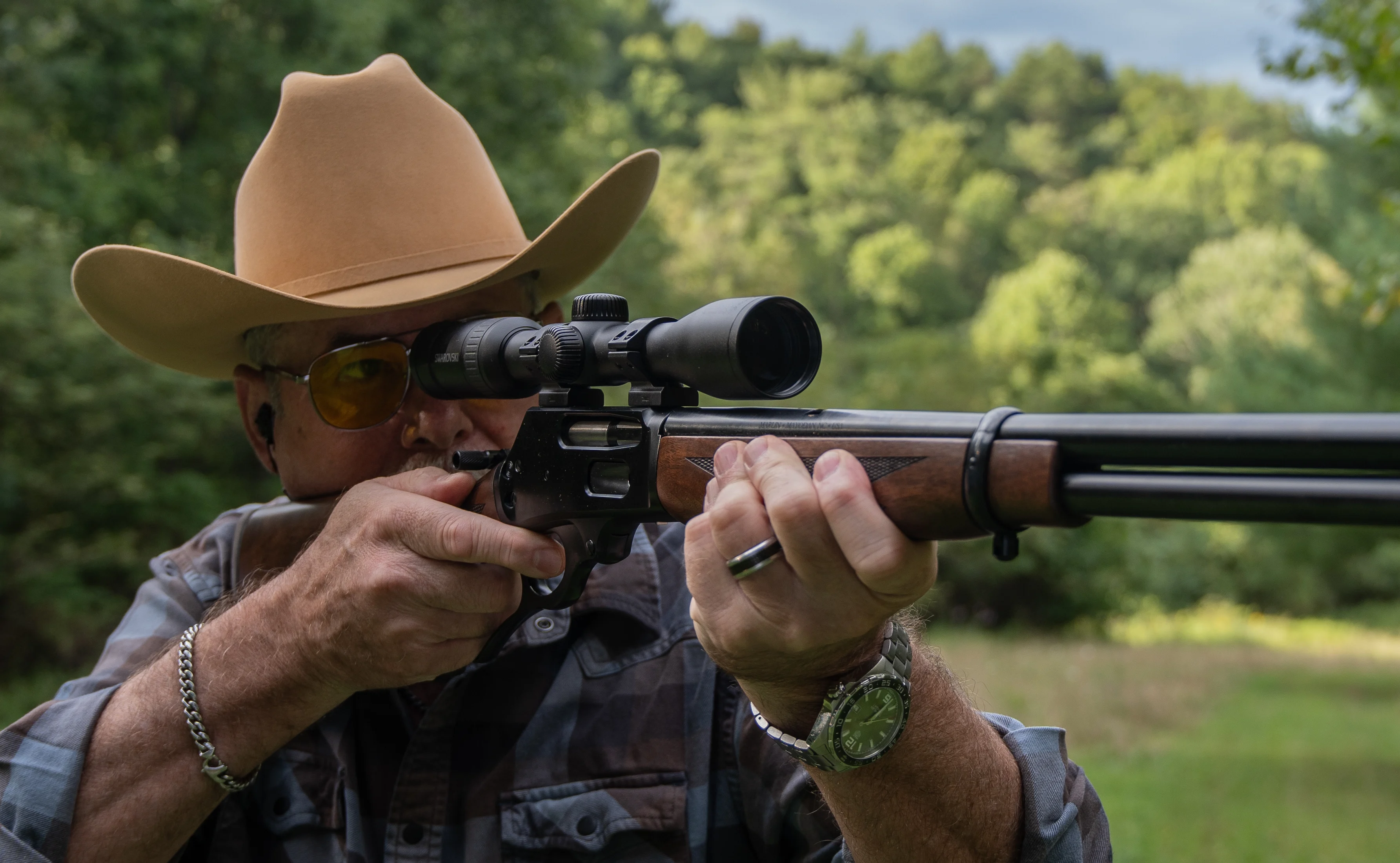
Unfortunately, to mount this scope low as it should be, we had to remove the rear sight on the Marlin Model 336 Classic. Because of that we opted to use the one-piece Talley Lightweight scope rings. With their integral bases, they provide a rock solid and lightweight mounting solution, and when we compared the weights of the scope and rings combined, this combo was the lightest tested.
The Swarovski Z3 line has been around a long time, and I’d not be surprised if it was soon updated. New versions might be better, but they might also be heavier and more expensive. Lightweight 3-9X scopes this compact are becoming extinct and are getting as hard to find as unicorn poop. If you like this rifle scope, I’d pick one up now. Either way, for us, there was no question this was the best of the bunch of all the scopes we tried out.
Best Budget (tie): Leupold VX Freedom 1.5-4X20mm
Specs
Length: 9.35 inches
Weight: 9.6 ounces
Mounting Space: 5.25 inches
Eye Relief: 3.7 to 4.3 inches
Adjustment Range: 125 MOA
Parallax Setting: 150 yards
Adjustment Value: 1/4 MOA
Field of View (feet @ 100 yards): 29.4 (5X) to 74.2 (1X)
Tube Diameter: 1 inch
Pros
Very affordable
Great magnification range for hunting in the timber
Lightweight and compact
Cons
Busy reticles
Leupold’s VX Freedom line of rifle scopes replaced their popular VX I and VX II lines in 2018. All VX Freedom scopes feature abrasion-resistant, military-spec lens coatings along with an enhanced power selector ring, and they’re built with Leupold’s Twilight Light Management System. They also have 1/4 MOA finger click adjustments, a 3-to-1 zoom ratio, and a 6061-T aluminum tube.
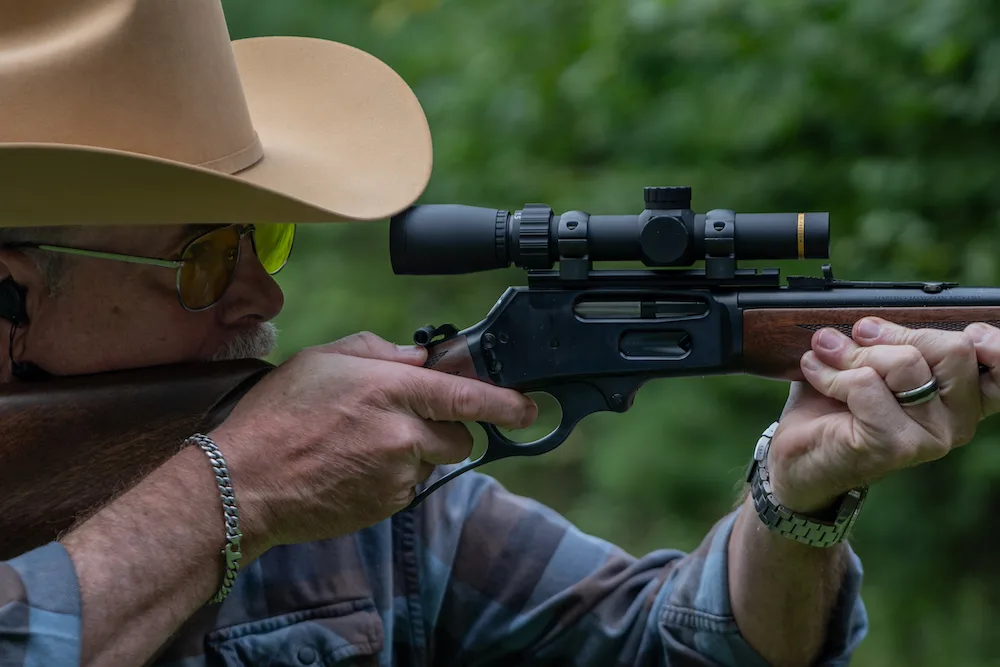
The VX Freedom 1.5-4X20mm rifle scope is available with a second focal plane MOA-Ring reticle, which features a large 40 MOA outer ring and seven additional aiming points located at 5 MOA increments below center. The scope is also available with the Pig-Plex second focal plane reticle, which features a 4.5 MOA circle in the center and additional aiming points positioned at 8.6, 12.6, or 17.3 MOA below reticle center. The additional aiming points with each reticle have no direct 100-yard increment correlation with 30-30 Winchester ballistics, but you could use them for range estimation or Kentucky windage type holdover assistance.
This was the lightest and most compact .30-30 scope we tested. With a generous 5.25 inches of mounting space along with the tube-diameter objective and small ocular housing, you can mount it very low without having to removing the rear sight. Using a Leupold one-piece base combined with quick-detach rings, you can easily switch between the scope and open sights. The low-end magnification of 1X allows for fast-action, up-close shots. On the other end of the spectrum, the maximum magnification of 4X leaves little to be desired in resolution and in low light performance. The scope performed flawlessly and would be an ideal companion to a .30-30 if you routinely hunt thick brush country with shots inside 100 yards.
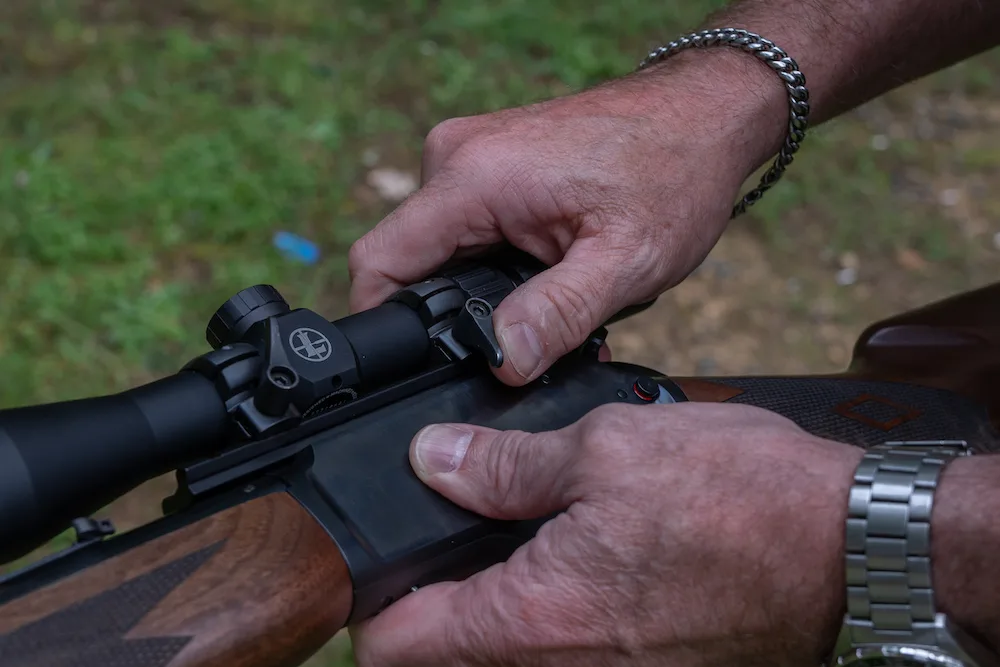
The MOA-Ring reticle was busy, but with some tweaking to your zero, you could use it for trajectory correction. The Pig-Plex reticle was less cluttered, but the subtensions of the additional aiming points do not align well with the trajectory of most common .30-30 Winchester loads. Considering the more practical short-range application of this scope, Leupold’s Duplex or Hunt-Plex reticle would have been a better choice, but they’re no longer offered. Also, the diopter/focus adjustment is of the older locking style, which is not very user friendly.

Still, we found this to be a good performing rifle scope that allows more versatility for mounting than optics with larger objectives. It was a clear choice for our budget award, especially for short range application.
Best Budget (tie): Leupold VX Freedom 2-7X33mm
Specs
Length: 11.04 inches
Weight: 11.1 ounces
Mounting Space: 4.85 inches
Eye Relief: 3.7 to 4.2 inches
Adjustment Range: 74 MOA
Parallax Setting: 150 yards
Adjustment Value: 1/4 MOA
Field of View (feet @ 100 yards): 29.8 (7X) to 43.8 (2X)
Tube Diameter: 1 inch
Pros
Very affordable
Great magnification range for general purpose hunting
Lightweight and compact
Cons
Short mounting space
Hunters have trusted Leupold’s VX rifle scopes for years. The newer VX Freedom scopes—which came out a few years ago—come with scratch-resistant lenses, a 3-to-1 zoom ratio, and a lockable eyepiece. They’re water-, fog-, and shock-proof, and they’re tested to withstand the repeated recoil of a 458 Lott, so .30-30 Winchester recoil should not be an issue.
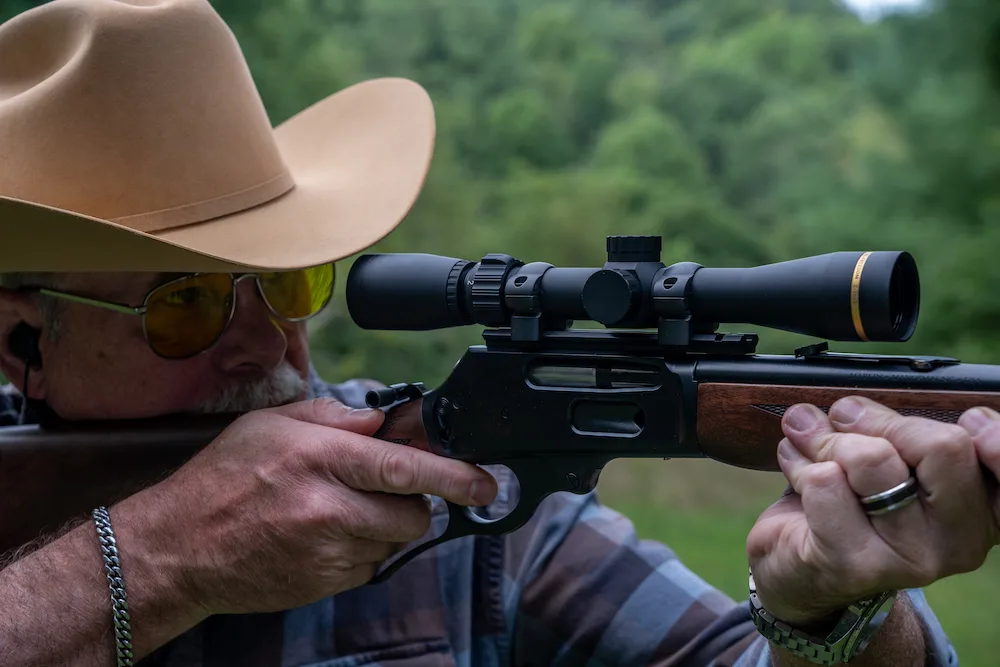
The VX Freedom 2-7X33mm rifle scope has a 1-inch tube and is available with Leupold’s second focal plane Hunt-Plex reticle, which is similar in design to the old German 4A reticle. It has three heavy and one thin post that meet with thin lines in the center. This is not a ballistic reticle, but the three thick posts tend to help reticle visibility in low light.
This scope was one of the most compact and lightweight we tested (similar to its sister scope above). Despite only having 4.85 inches of mounting space, it has 3.7- to 4.2-inch eye relief, which was the best in our tests. This makes positioning the scope less critical and the small objective housing allows for the scope to mounted very low above the bore. Depending on how you set up the eye relief, you might get by without removing the rifle’s rear sight. Using a Leupold one-piece rail and the lowest quick release rings we could find, we had to fold the rear sight down on the Marlin 336 Classic, but with the quick-detach rings we could go between the scope and open sights quickly. Like with the 1.5-4X20mm VX Freedom, the diopter adjustment is of the old lockable style and does not lend itself to fast, fine-tuning.
The scope performed to perfection in our testing. The low-end magnification of 2X allowed for fast target acquisition for close-in shots, and the maximum magnification of 7X gave us a bit more reach than the 1.5-4X20 VX Freedom, which is priced the same. While the high-end magnification is sufficient for hitting out to the limits of the .30-30 Winchester cartridge, a bit more magnification could provide additional resolution when you need to separate a deer from a tangle of deep timber shade and brush. The Hunt-Plex reticle is easy to see and stupid simple; it offers no trajectory compensation but will not confuse you, either.
This is an excellent performing scope with a practical power range that pairs well with the ballistics of the .30-30 Winchester. It was a clear choice for our budget award but had to share that distinction with the above 1.5-4X20mm VX Freedom riflescope, which would be a better choice for those who hunt the confines of thickly forested ground where shots are generally very close.
Best for Hunting: Trijicon 3-9X40mm AccuPoint
Specs
Length: 12.2 inches
Weight: 13.4 ounces
Mounting Space: 5.3 inches
Eye Relief: 3.2 to 3.6 inches
Adjustment Range: 50 MOA
Parallax Setting: 100 yards
Adjustment Value: 1/4 MOA
Field of View (feet @ 100 yards): 11.3 (9X) to 33.8 (3X)
Tube Diameter: 1 inch
Pros
Battery-free illuminated reticle
Good resolution
Good reticle options for hunting
Cons
Expensive
The Trijicon AccuPoint has a 3-to-1 zoom ratio, and it looks a bit odd due to the glass window on the ocular housing. This window allows light to reach the Tritium/fiber optic portion of the rifle scope that powers the battery-free illuminated reticle. There’s also a shield you can rotate to partially or fully cover this window. This lets you adjust the brightness of the single dot at the center of a second focal plane Duplex-style reticle.
An alternate post reticle is available, and as with the Duplex-style reticle, it offers no ballistic correction. However, this reticle is supposed to better facilitate both-eyes-open shooting and exemplifies Trijicon’s Bindon Aiming Concept. Theoretically, this allows for faster engagement, especially on moving targets. Both reticles are available with either red, amber, or green illumination.
The 40mm objective lens sets the external objective housing diameter at 1.65 inches. This will require you to mount the scope about a half inch above the receiver/barrel. The AccuPoint has 5.3 inches of mounting space, which combined with the 3.2 to 3.6 inches of eye relief, allows some mounting flexibility. The parallax is factory set at 100 yards, and the scope has 50 MOA of adjustment range with adjustments that are 1/4 MOA per click. The windage and elevation dials are capped, but they’re also resettable to zero by lifting and rotating the finger dial. Diopter adjustment is of the easy/fast focus Euro-style, and you can easily tune it to your eye.
We mounted the Trijicon 3-9X40mm AccuPoint with the Talley Lightweight low-height scope rings. This kept weight down but required us to remove the Marlin’s rear sight. Optically, we found the Trijicon just a tad behind the Swarovski but a bit better than the 2-10X40mm Burris. The illuminated reticle is a bonus, but if optical clarity and low light performance is your priority, you might like the Swarovski better.
On the plus side, these .30-30 rifle scopes have been around for a long time and have proven themselves in the field. When all features were considered, we felt that for general purpose hunting, the advantage of the non-battery-powered illuminated reticle was enough to justify the Trijicon AccuPoint’s distinction as the best hunting scope for a .30-30. As most experienced hunters know, the best chance for a nice buck often comes in the first or last 30 minutes of daylight. In those conditions, an illuminated reticle can make a difference.
More 30-30 Scopes We Tested
Best of the Rest: Burris Signature HD 2-10X40mm
Specs
Length: 11.75 inches
Weight: 17.6 ounces
Mounting Space: 4.74 inches
Eye Relief: 3.5 to 3.8 inches
Adjustment Range: 120 MOA
Parallax Setting: Not Listed
Adjustment Value: 1/4 MOA
Field of View (feet @ 100 yards): 10.8 (10X) to 54.0 (2X)
Tube Diameter: 1 inch
Pros
Good resolution
External and lockable adjustments
Not too expensive
Useable ballistic reticle
Cons
Short mounting space
Heavy
We included the Burris Signature HD 2-10X40 in the test because of its 5X magnification range but also because of the optical quality we felt it delivered for less than $500. The subtensions for the scopes’ Ballistic E3 reticle will work well for the hunter armed with a .30-30 Winchester. The difference is that the additional aiming points will not coincide with ranges in 100-yard increments. Fortunately, much like Swarovski, Burris has a web-based app that allows you to tune the reticle to match your ammunition. It’s a wonderful asset.
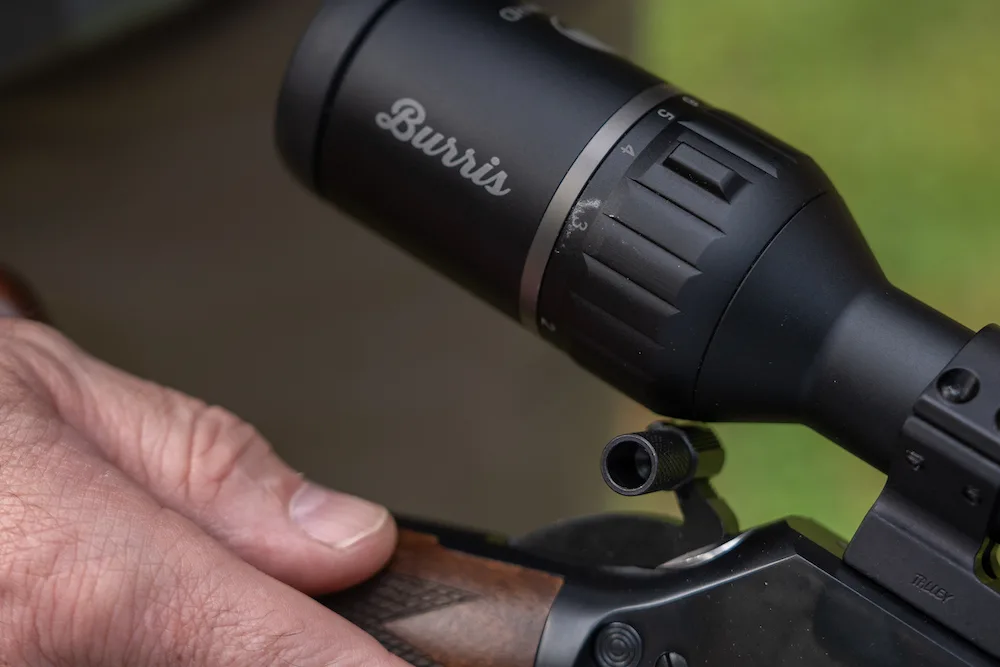
The Signature HD had the largest ocular and objective bell diameters of the scopes we evaluated, and it also had the least amount of mounting space. For it to work on the Marlin 336 Classic we had to remove the rifle’s rear sight, and use the low-height (0.52-inch) Talley Lightweight scope rings. (The 0.62-inch medium height rings would allow more clearance for hammer operation.) The scope comes with exposed windage and elevation turrets that you lift to unlock, and they’re zero resettable.
The Signature HD has decent eye relief and fully coated optics, and Burris advertises it as water-, shock-, and fog-proof. It also comes with the Burris Forever warranty, which guarantees the scope to be free from manufacturing defects for the product’s lifetime.
Though dialing a shooting solution is not something generally done with rifle cartridge like the .30-30 Winchester, in some hunting situations it could be an asset. If it’s a feature you don't plan on using, ignore it; the adjustments on the Burris are locked in place. However, the shoot house or stand hunter who watches an open field should not overlook the benefit they can offer.
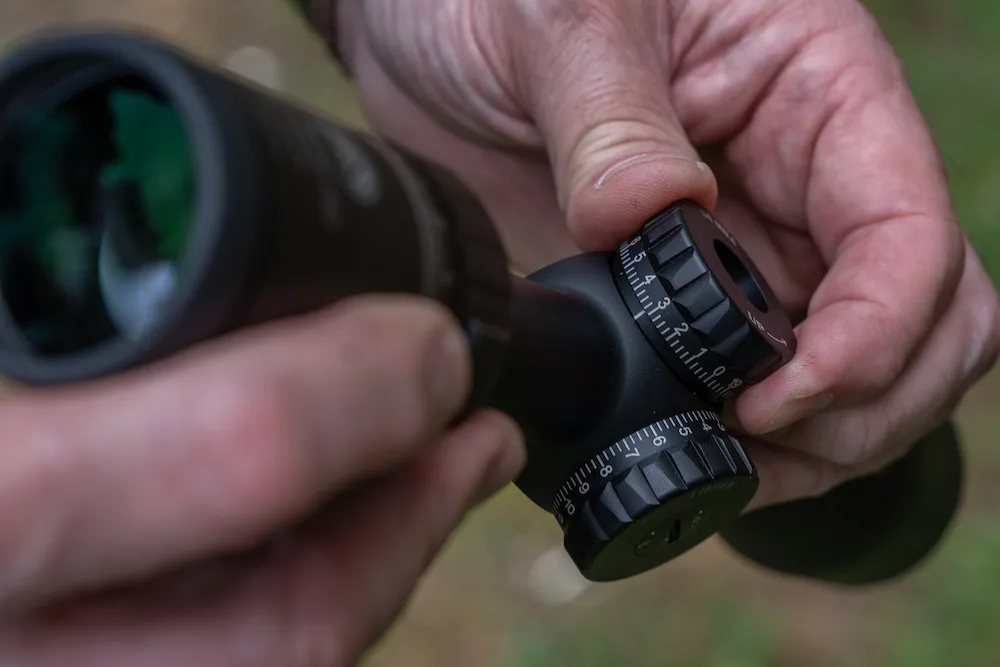
Weighing more than a pound, the Burris was the heaviest rifle scope we tested and this weight did nothing to enhance the handling qualities of the Marlin. But, if you're a stand or shoot house hunter, you probably would not care. For those who hunt from their feet and expect to make a snap shot at an escaping whitetail, this heavy scope and its busy reticle will do you no favors.
The Burris Signature HD performed to perfection, but with its external adjustments and ballistic reticle, it represents the modern take on rifle scopes, which are generally optimized for long range shooting and for cartridges with long range reach. If that’s the world you live in, you might appreciate those features on a scope for a .30-30 rifle.
Best of the Rest: Leupold VX Freedom 1.5-4X28mm IER Scout Duplex
Specs
Length: 11.1 inches
Weight: 9.6 ounces
Mounting Space: 4.50 inches
Eye Relief: 6.0 to 6.9 inches
Adjustment Range: 125 MOA
Parallax Setting: 150 yards
Adjustment Value: ¼ MOA inch
Field of View (feet @ 100 yards): 17.3 (4X) to 41.7 (1.5X)
Tube Diameter: 1 inch
Pros
Compatibility with rail and aperture sight
Great magnification range for hunting in the timber
Lightweight
Affordable
Cons
Not useable with traditional mounts—requires receiver/barrel rail
This is one of the most unique scopes in the Leupold line. It is essentially their VX Freedom 2-7X33mm with a different ocular housing. This gives this lightweight and compact rifle scope an intermediate eye relief (IER) of between 6.0 to 6.9 inches. Though not really a scout scope—true scout scopes have about 10 inches of eye relief—this Leupold pairs perfectly with lever guns outfitted with a long rail and an integral aperture sight. With quick-release scope rings, you can go between open sights and the scope with just the simple turn of two levers. The downside is that this scope will only work on a lever gun with a long rail.
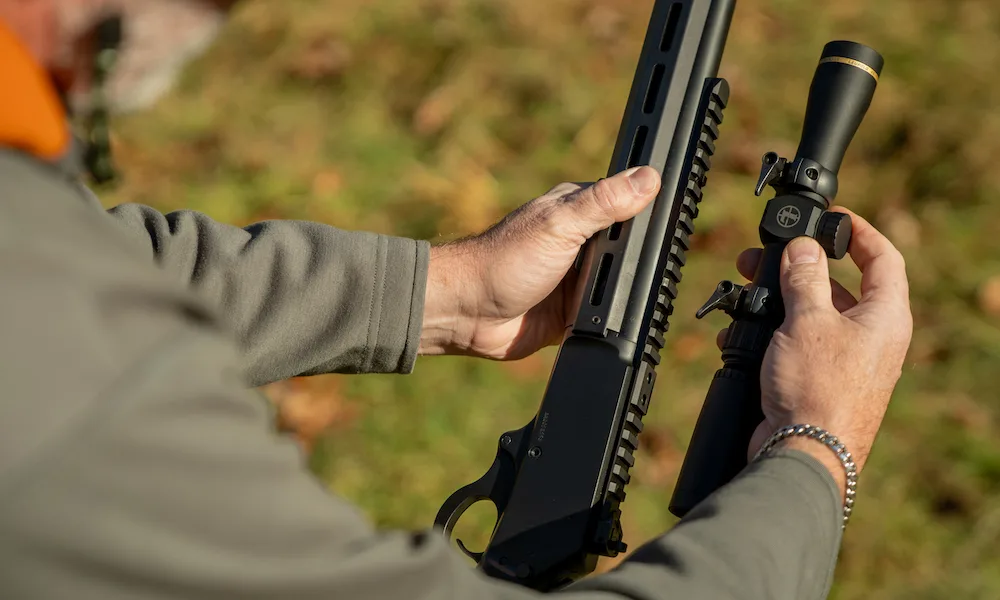
Because of the scope’s long eye relief, the field of view is a bit diminished. But with an 8.5-foot field of view at 50 yards on 4X, it’s plenty wide to follow or track a whitetail moving through the timber. Like all the other rifle scopes in the VX Freedom line, Leupold builds this scope around their Advanced Optical System which delivers good glare reduction, resolution, and clarity. The 1.5-4X28mm IER Scout scope is only available with the Duplex reticle, and it’s completely fog-proof and waterproof. It's also made in the USA, and guaranteed for life.

This is a specialty scope intended for use with a lever-action rifle with a rail. If that’s the .30-30 you have, this could arguably be the best overall, best budget purchase, and the best hunting scope in our test. However, if you’re inexperienced with extended eye relief optics, you’ll likely find there’s a learning curve when it comes to using them efficiently. Some shooters struggle with the concept and they never really adapt to it or to shooting with both eyes open, which is what makes this scope work as intended. During testing, we had no issues with this scope.
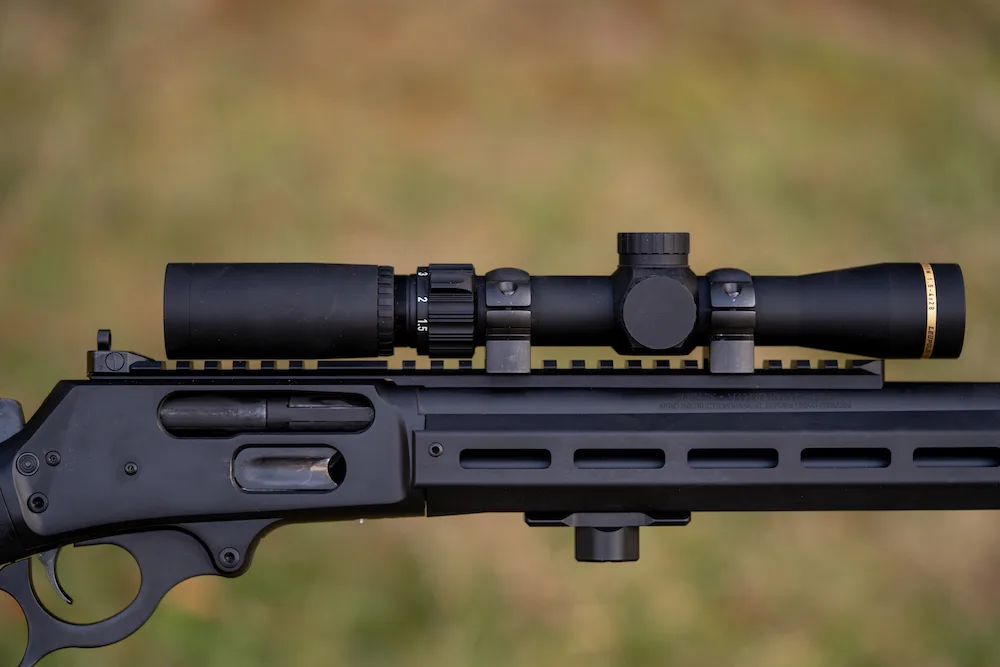
It's worth noting that more and more lever guns are being made with full length rails, and a lever gun so equipped—especially when paired with an aperture rear sight—brings a lot of versatility to the table. The main detractor with this scope is the low power, high-end magnification setting of 4X. It will serve you well in the timber or for close-in shots, but it lacks the resolution most hunters expect for longer range application. If you expect to stretch the distance with your .30-30, forget this rifles cope and the rail, and go with a traditional scope with a higher magnification range.
How We Tested the Scopes
A rifle scope allows your eye to interface with your rifle. It’s how you direct your bullets to the spot you want to hit. For this to happen, you need to be able to zero the scope precisely and the scope must hold that zero. To evaluate the adjustments and repeatability, we mounted every scope in the test to a fantastically good shooting Wilson Combat NULA Model 20 in 300 HAMR. After zeroing, we fired a box drill.
Then we mounted and zeroed each scope to a brand new Marlin 336 Classic rifle in 30-30 Winchester using a variety of mounts. Then we shot from the bench and from field positions using Buffalo Bore’s 150-grain TSX ammunition to see how these scopes interfaced with the rifle, and to see how we interfaced with the scopes. Next, we removed each scope, dropped it the ground from head height three times, remounted it, and checked functionality, again.
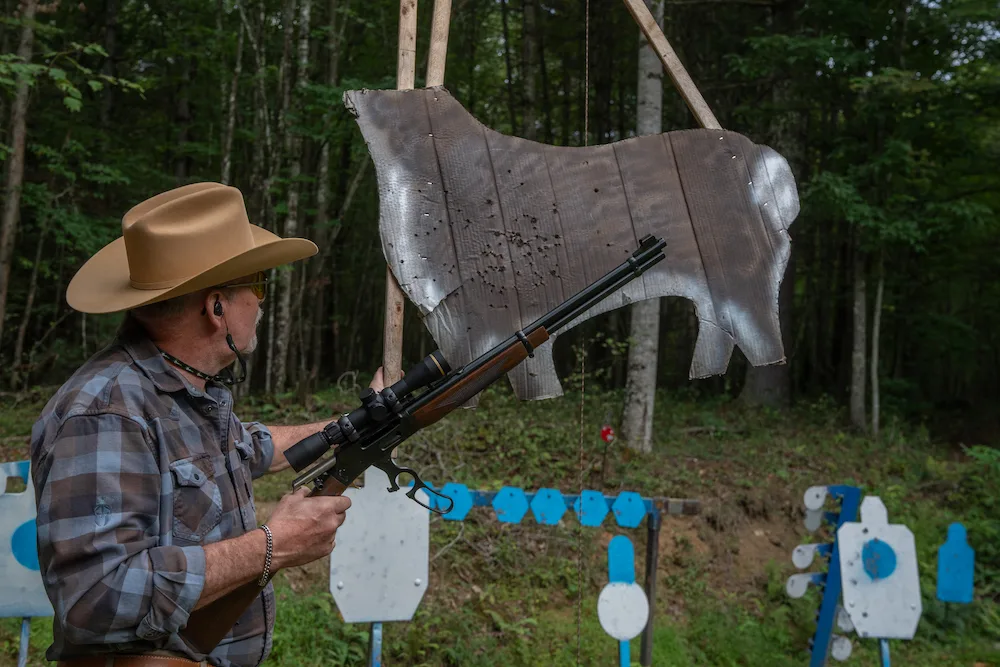
A scope should allow you to see your target clearly and this requires good glass, good lens treatments, and exactness in assembly. For this evaluation, we placed an optics chart in the shade and in good light at 100 yards. Then we evaluated brightness and resolution. Because a scope must also perform in harsh conditions, we dunked each scope in 10 inches of water for 30 seconds and tossed it in the freezer. We reevaluated them the next day.
We scored the scopes in five categories—optical performance, user interface, adjustment repeatability, size and weight, and price—and added up the points. Then we awarded an overall winner, the best budget scope, and the best scope for hunting.
FAQs
Q: How do you mount a scope on a .30-30?
Most modern .30-30 lever-action rifles are factory drilled and tapped for scope bases; you’ll just need to select the proper base for your rifle and then pick out the scope rings you want to use. Some modern lever guns come with a rail for scope attachment and Skinner sights offers a scope base with an integral aperture sight that will work with Talley steel rings. The easiest way to mount a rifle scope to some modern .30-30s—like those from Henry, Marlin, or Rossi—is with Talley’s Lightweight one-piece mounts that do not require a separate base.
Q: Can you put a scope on a lever-action rifle?
This answer is a bit complex because there are a lot of different types of lever-action rifles. Some older lever actions were not drilled and tapped for scope mounting and will require gunsmith assistance. Also, with some older Winchester lever actions and clone, you must mount the scope to the side of the receiver as opposed to the top because of the top eject feature. However, with the help of a gunsmith, it’s almost always possible to mount a scope on most any lever action. With most modern lever-action rifles, you can usually mount your rifle scope on your own with scope bases and rings available across the counter.
Final Thoughts
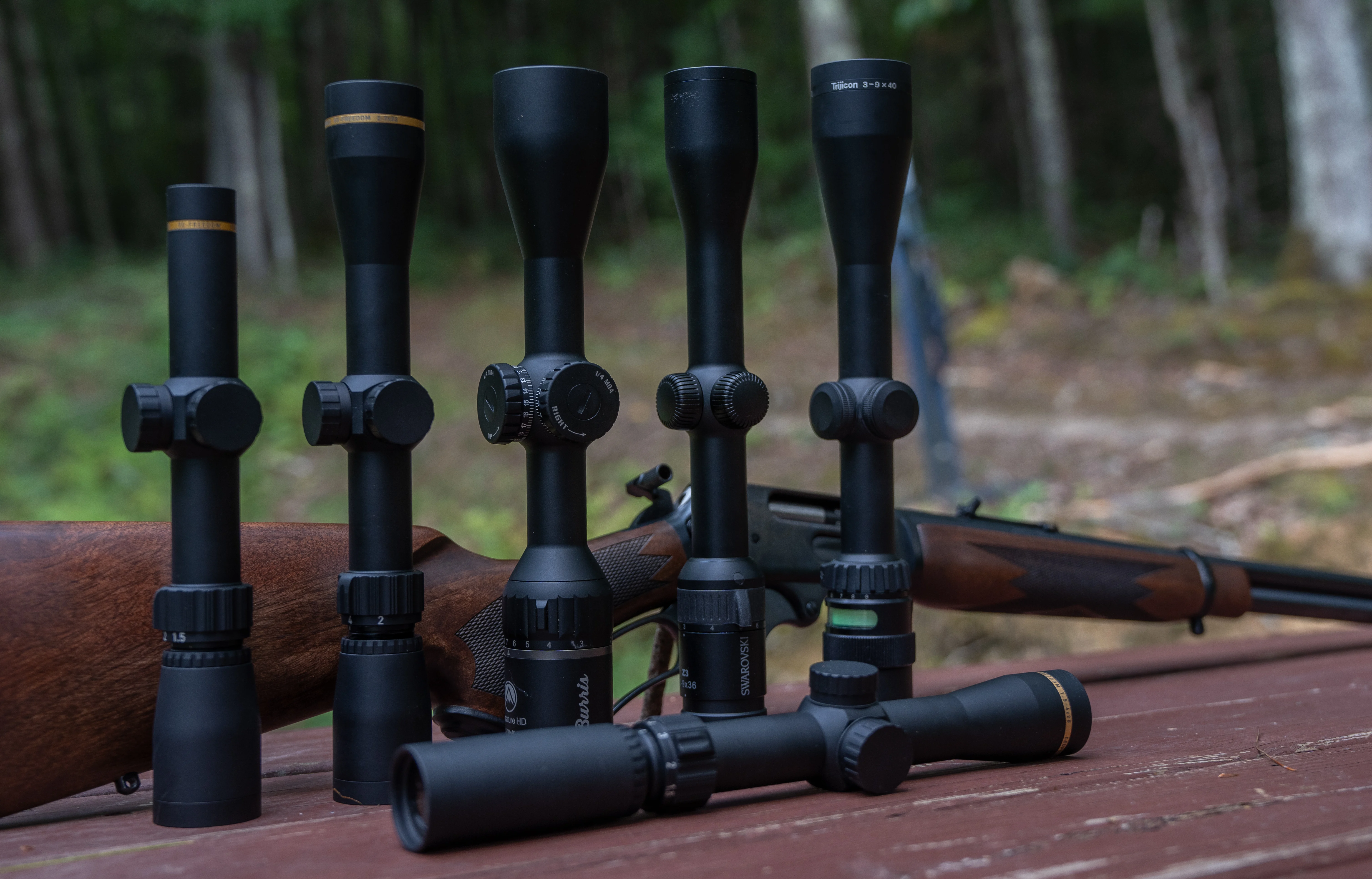
People have been putting scopes on .30-30 rifles for well over 100 years. In that time, there’s one thing that we know for sure: There really is no one best scope for the .30-30 cartridge. Because of its incredible versatility and performance, this round is used for a bunch of different purposes. As a result, these different guns with their varying barrel lengths or other possible modifications benefit from different types of scopes. Choose from the selections above to ensure you get one of the best scopes for .30-30 rifles.
Why Trust Us
For more than 125 years, Field & Stream has been providing readers with honest and authentic coverage of outdoor gear. Our writers and editors eat, sleep, and breathe the outdoors, and that passion comes through in our product reviews. You can count on F&S to keep you up to date on the best new gear. And when we write about a product—whether it’s a bass lure or a backpack—we cover the good and the bad, so you know exactly what to expect before you decide to make a purchase.

